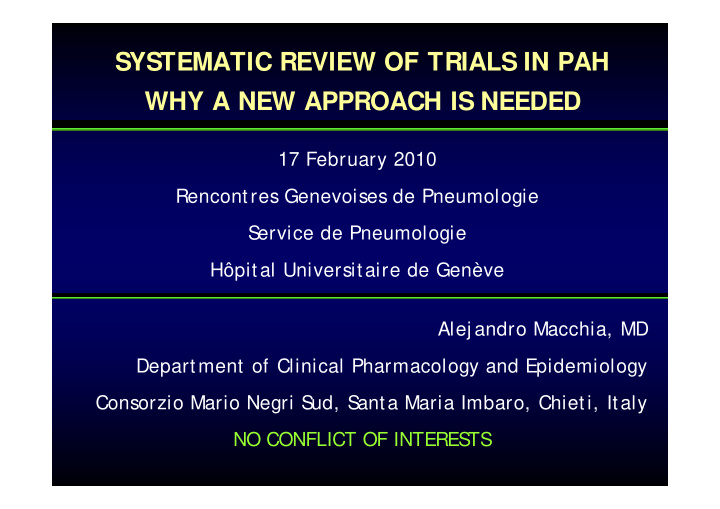



SYSTEMATIC REVIEW OF TRIALS IN PAH WHY A NEW APPROACH IS NEEDED 17 February 2010 Rencontres Genevoises de Pneumologie S ervice de Pneumologie Hôpital Universitaire de Genève Alej andro Macchia, MD Department of Clinical Pharmacology and Epidemiology Consorzio Mario Negri S ud, S anta Maria Imbaro, Chieti, Italy NO CONFLICT OF INTERES TS
1. The state of the art 2. The historical/pharmacological framework 3. Key words for PAH • behind/ beyond • to look forwards
SYSTEMATIC REVIEW OF TRIALS IN PAH EPO & PCA TRIALS (9; n=1,241) Trial N ACRONYS M Rubin (1990) 23 - Epoprostenol Barst (1996) 81 PPHS G Epoprostenol Badesch (2000) 111 - Epoprostenol Olschewski (2002) 203 AIR Iloprost Galiè (2002) 130 ALPHABET Beraprost S immoneau (2002) 470 TS G Treprostinil Barst (2003) 116 BS G Beraprost McLaughlin 67 S TEP Iloprost Hoeper 40 COMBI Iloprost
SYSTEMATIC REVIEW OF TRIALS IN PAH ETRA TRIALS (9; n=1,274) Trial N ACRONYS M Channick (2001) 32 BPH Bosentan Rubin (2002) 213 BREATHE -1 Bosentan Barst (2003) 178 S TRIDE-1 S itaxentan Humbert (2004) 33 BREATHE-2 EPO + Bosentan EPO Galiè (2008) 202 ARIES 1 Ambrisentan Galiè (2008) 192 ARIES 2 Ambrisentan Barst (2006) 185 S TRIDE 2 S itaxentan Galiè (2006) 54 BREATHE 5 Bosentan Galiè (2008) 185 EARLY Bosentan
SYSTEMATIC REVIEW OF TRIALS IN PAH PDT5I TRIALS (8; n=1,004) Trial N ACRONYS M Ghofrani 30 S and IS PH S ildenafil S ildenafil + Iloprost Ghofrani 16 S LFPH S ildenafil EPO S astry 22 S PPH S ildenafil Galié 278 S UPER-1 S ildenafil Wilkins 26 S ERAPH S ildenafil Bosentan S immonneau 267 PACES EPO + S ildenafil EPO S ingh 40 S TPAH S ildenafil Galié 164 PHIRS T20 Tadalafil Galié 161 PHIRS T40 Tadalafil
Trial N ACRONYSM Rubin (1990) 23 - NO Barst (1996) 81 PPHSG NO Badesch (2000) 111 - NO Olschewski (2002) 203 AIR NO Galiè (2002) 130 ALPHABET NO Simmoneau (2002) 470 TSG NO Barst (2003) 116 BSG YES McLaughlin 67 STEP NO Hoeper 40 COMBI NO Channick (2001) 32 BPH NO Rubin (2002) 213 BREATHE -1 NO Barst (2003) 178 STRIDE-1 NO Humbert (2004) 33 BREATHE-2 NO Galiè (2008) 202 ARIES 1 NO Galiè (2008) 192 ARIES 2 NO Barst (2006) 185 STRIDE 2 NO Galiè (2006) 54 BREATHE 5 NO Galiè (2008) 185 EARLY NO Ghofrani 30 S and ISPH NO Ghofrani 16 SLFPH NO Sastry 22 SPPH NO Galié 278 SUPER-1 NO Wilkins 26 SERAPH NO Simmonneau 267 PACES NO Singh 40 STPAH NO Galié 164 PHIRST20 NO Galié 161 PHIRST40 NO
WHAT (OUTCOMES) RCT TESTED ? 100% 1 / 26 CLINICAL (<5% ) 2 / 26 Other non clinical (8% ) 90% 4 / 26 Haemodynamics (15% ) 80% 70% 60% 50% 40% 19 / 26 Exercise Capacity 30% (73% ) 20% 10%
1 Year WHAT WAS THE DURATION OF RCT ? 5% 6 Months 5% 18 Weeks 90%
The only trial that address mortality as a primary point failed to demonstrate any benefit BERAPROS T PLACEBO P MONTH 3 0 / 60 3 / 56 Death 0 0 0.109 Rescue 0 2 Desaturation 0 1 MONTH 6 1 / 60 11 / 56 Death 0 2 0.002 Rescue 1 6 Desaturation 0 3 MONTH 9 8 / 60 15 / 56 Death 1 2 0.102 Rescue 4 7 Desaturation 3 6 MONTH 12 10 / 56 15 / 52 Death 1 2 0.254 Rescue 5 7 Desaturation 4 6 Barst RJ.JACC 2003;41:2119-25
If they would studied excercise capacity at 3-6 months, probably Beraprost would be approved it p=0.010 p=0.016 p=0.098 p=0.180 N=60 Change in the 6 ‘ walking distance 20 N=60 N=60 10 N=60 N=52 0 N=56 N=56 -10 -20 N=56 N=47 N=56 -30 Baseline 3 6 9 12 months months months months Barst RJ.JACC 2003;41:2119-25
Key words Behind/beyond 1. Rare diseases: incidence, prevalence, clinically oriented epidemiology 2. Problem vs drug oriented trials 3. Registration requirements clinical vs relevance 4. Science vs ethics
Key words To look/forwards 1. Representative networks 2. RCTs as a component of prospective outcome oriented epidemiology (“effectiveness monitoring”) 3. Hard outcomes as a guide to understand surrogate/intermediate end-points
Recommend
More recommend